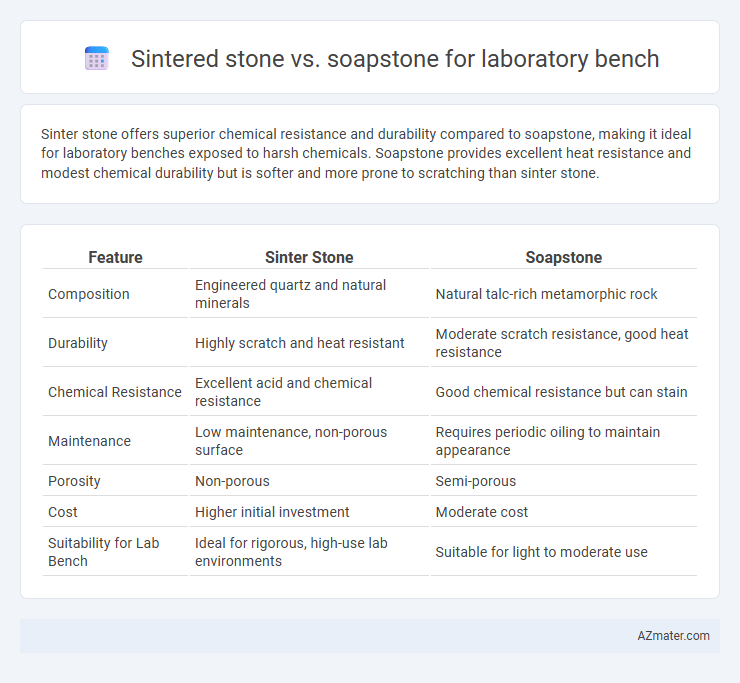Sinter stone offers superior chemical resistance and durability compared to soapstone, making it ideal for laboratory benches exposed to harsh chemicals. Soapstone provides excellent heat resistance and modest chemical durability but is softer and more prone to scratching than sinter stone.
Table of Comparison
| Feature | Sinter Stone | Soapstone |
|---|---|---|
| Composition | Engineered quartz and natural minerals | Natural talc-rich metamorphic rock |
| Durability | Highly scratch and heat resistant | Moderate scratch resistance, good heat resistance |
| Chemical Resistance | Excellent acid and chemical resistance | Good chemical resistance but can stain |
| Maintenance | Low maintenance, non-porous surface | Requires periodic oiling to maintain appearance |
| Porosity | Non-porous | Semi-porous |
| Cost | Higher initial investment | Moderate cost |
| Suitability for Lab Bench | Ideal for rigorous, high-use lab environments | Suitable for light to moderate use |
Introduction to Laboratory Bench Materials
Sintered stone offers exceptional durability and resistance to heat, chemicals, and scratches, making it ideal for demanding laboratory environments. Soapstone provides excellent chemical resistance and heat stability but tends to be softer and more prone to scratches compared to sinter stone. Selecting the right laboratory bench material depends on the specific requirements for durability, chemical resistance, and maintenance in scientific settings.
What is Sinter Stone?
Sinter stone, also known as sintered stone, is an engineered material made by compacting natural minerals such as quartz, feldspar, and porcelain under extreme pressure and high heat, resulting in a dense, durable surface ideal for laboratory benches. It offers superior resistance to chemicals, heat, and scratches compared to traditional soapstone, making it highly suitable for environments requiring stringent safety and durability standards. The low porosity of sinter stone prevents staining and bacterial growth, ensuring a hygienic and maintenance-friendly workspace in professional labs.
What is Soapstone?
Soapstone is a natural metamorphic rock composed primarily of talc, which gives it a smooth, soapy texture and excellent chemical resistance, making it ideal for laboratory benches exposed to acids and corrosive substances. Its dense, non-porous surface withstands heat and does not react with most chemicals, ensuring durability and easy maintenance in laboratory environments. Compared to sinter stone, soapstone offers superior resistance to chemical damage but may be softer and more prone to scratching.
Durability: Sinter Stone vs Soapstone
Sinter stone offers superior durability compared to soapstone, exhibiting enhanced resistance to scratches, stains, and heat, making it ideal for rigorous laboratory environments. Soapstone, while naturally heat-resistant and chemically stable, is softer and more prone to scratching and denting under heavy use. The denser, engineered composition of sinter stone ensures longer-lasting performance and minimal maintenance in demanding laboratory settings.
Chemical Resistance Comparison
Sinter stone exhibits superior chemical resistance to a wide range of acids and solvents commonly used in laboratory settings, outperforming soapstone, which is more susceptible to etching and staining from strong chemicals. The dense, non-porous structure of sinter stone minimizes absorption and degradation, ensuring prolonged durability under aggressive chemical exposure. Soapstone, primarily composed of talc, offers moderate resistance but can deteriorate when exposed to highly acidic or alkaline substances over time.
Maintenance and Cleaning Requirements
Sinter stone requires minimal maintenance due to its high resistance to stains, chemicals, and heat, making it ideal for laboratory benches where frequent cleaning is essential. Soapstone, while naturally non-porous and resistant to acids, demands regular oiling to maintain its appearance and prevent surface wear during cleaning. Both materials offer durability, but sinter stone's low-maintenance surface reduces downtime and cleaning effort in high-use lab environments.
Heat Resistance Capabilities
Sintered stone offers superior heat resistance compared to soapstone, withstanding temperatures up to 1200degF (650degC) without damage, making it ideal for laboratory benches exposed to high-temperature equipment or experiments. Soapstone provides good heat resistance, tolerating temperatures around 600degF (315degC), but may discolor or crack under prolonged or intense heat. Laboratories requiring durable, heat-resistant surfaces typically prefer sintered stone for its enhanced thermal stability and low thermal expansion properties.
Cost Analysis: Sinter Stone vs Soapstone
Sinter stone offers a higher initial cost compared to soapstone due to advanced manufacturing processes and enhanced durability suitable for laboratory benches. Soapstone presents a more budget-friendly option with moderate resistance to chemicals and heat but may incur increased maintenance costs over time. Evaluating long-term expenses, including potential replacements and upkeep, is essential for choosing between sinter stone's longevity and soapstone's affordable upfront investment.
Aesthetic Differences for Laboratory Design
Sinter stone features a sleek, uniform appearance with consistent color and fine grain, offering a modern and polished look ideal for contemporary laboratory bench designs. Soapstone displays natural veining and subtle color variations ranging from gray to greenish hues, contributing to a warmer, rustic aesthetic that enhances traditional or vintage laboratory environments. Choosing between Sinter stone and Soapstone for laboratory benches depends on the desired balance between a clean, minimalist style and a textured, organic visual appeal.
Choosing the Right Material for Your Laboratory Bench
Sintered stone offers superior chemical resistance and durability compared to soapstone, making it ideal for high-impact laboratory environments where exposure to acids and solvents is frequent. Soapstone provides excellent thermal resistance and moderate chemical resistance but requires regular sealing to prevent staining and wear. Selecting the right material depends on the laboratory's specific chemical exposure, maintenance capabilities, and budget considerations.

Infographic: Sinter stone vs Soapstone for Laboratory bench
 azmater.com
azmater.com